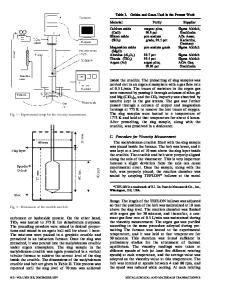Adhesion of Thin Metal Films to Vacuum-Cleaved SiO 2 , Al 2 O 3 , and MgO Substrates
- PDF / 289,113 Bytes
- 5 Pages / 420.48 x 639 pts Page_size
- 67 Downloads / 292 Views
ADHESION OF THIN METAL FILMS TO VACUUM-CLEAVED Si0 2 , A1 2 0 3 AND MgO SUBSTRATES ANDRIS SIMANOVSKIS, SARA STOLYAROVA AND SILVIA VARCHENYA Institute of Physics, Latvian Academy of Sciences, 229021, Riga, Salaspils, Latvia ABSTRACT The adhesion of Au, Ag, Pb,Sn, In, Cu, Cd, Mg, Ca films to vacuum-cleaved A1 2 0 3 ,MgO and SiO, single crystals has been studied. It is shown, 'that for both Al 0 and igO the level of adhesion is slightly higher than that 3for SiO2 and tends metals. As to increase with chemical activity of deposited a result, the adhesion varies from the level of van der Waals forces to the level of chemical interaction. INTRODUCTION There are many reports devoted to the problem of thin metal film adhesion to oxide substrates I-15) .However there are also many reasons to take up this problem. As a rule,data for a few film-substrate pairs are given in each work, and it is difficult to compare results obtained by different authors because of the use of various methods for adhesion testing and substrate surface preparation. Glow discharge and chemical treatments were often used for cleaning the surfaces. However, it was shown later that the glow discharge leads to modification of substrate surface A6), resulting in the change of adhesion of thin films. To study the general behaviour of adhesion interaction between metal film and given oxide substrate it is necessary to deal with atomically clean and unmodified surfaces.Earlier we had studied the adhesion of metal films to SiO and glass vacuum-cleaved substrates [7-B]. The purpose of the present work was to compare the adhesion of a number of metals with different chemical activity to different oxide substrates. We report here experimental studies of the adhesion of Au,Ag, Pb,Sn,Cd,ln,Cu,Mg,Ca to vacuum-cleaved surfaces of Si0 2 ,A1 2 0 3 and MgO single crystals. EXPERIMENTAL PROCEDURE We studied thin polycrystalline metal films 500 nm thick, deposited onto juvenile (free from contaminants) oxtde crystal Pa at surfaces by thermal evaporation in a vacuum of IO room temperature. The condensation rate was 10 nm per second. The juvenile contacts were obtained by crystal cleaving in a flow of metal vapour. We found experimentally the time between the cleavage of the crystal and the moment when metal vapour reached the cieaved surface to be 0.05 s. At a condenit takes 0.04 s to condense a monolayer sation rate 10 nm sof the metal atoms. Hence, the cleaved surface is opened to Mat. Res. Sac. Symp. Proc. Vol. 239. @1992 Materials Research Society
600
residual gas molecules for 0.09 s. At the presure of IO-4 Pa during 0.1 s approximately 0.04 monolayers of gas molecules can be formed on the crystal surface if the sticking coefficient is equal to I. In fact, the latter is always less than I and the upper limit of possible pollution of metal-crystal contact is less than 0.04 monolayer in our case. We believe that it does not play--a significant role in adhesion and does not change conformity with the law of given oxide-metal interaction. The small size of Al 0 and
Data Loading...









